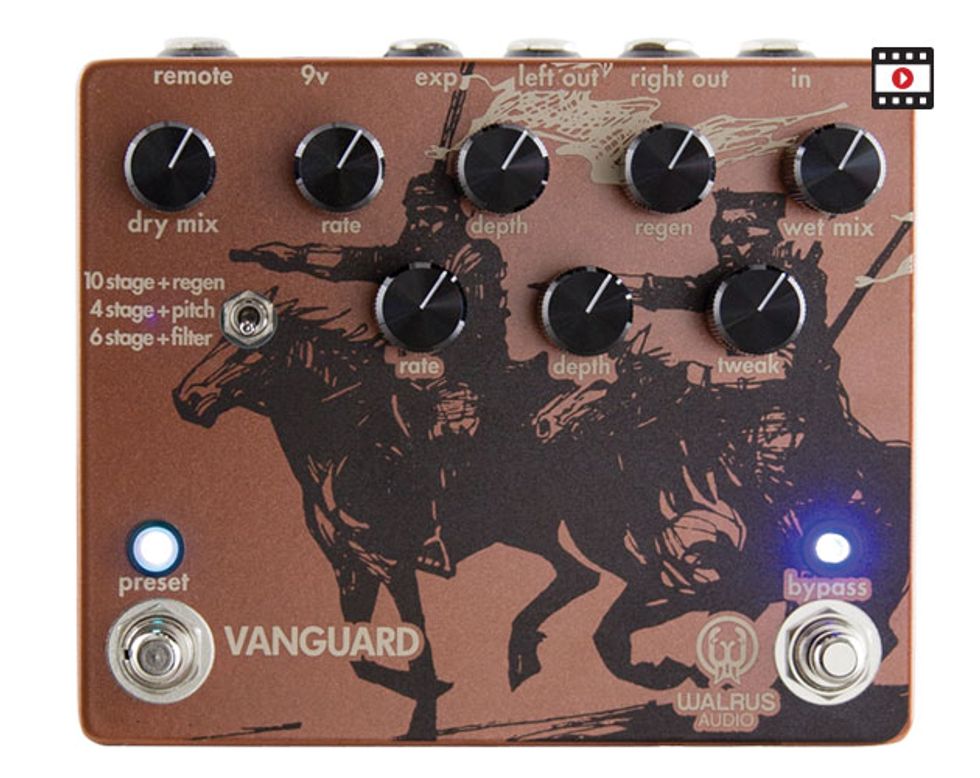Walrus Audio’s Vanguard puts a new twist on an old idea, with an emphasis on the word “twist.” The old idea is combining two independent phase shifters in one box. But the Vanguard’s tones and features are quite distinct from such analog precedents as the 1970s Mu-Tron Bi-Phase, the rare but revered Lovetone Doppelganger from the ’90s, and MXR’s simple but effective Phase 99.
Instead, Vanguard is an unapologetically digital effect. It doesn’t replicate the cushy, immersive sound of a good analog phaser, but has an edgier modern character. And it offers an array of options you won’t find on most analog phasers, including true stereo operation, remote and expression controls, and fresh-sounding bi-phased colors.
Squirrely Swirl
Vanguard runs on any 9V power supply rated at 150 milliamps or higher. As on most modern digital effects, battery power is not an option. The pedal actually houses four phaser circuits. The first one, always active, is a 10-stage phaser with standard rate, depth, and feedback controls. This stage’s output feeds one of three second-stage phasers, selectable via toggle switch. You can choose between a duplicate of the first phaser, a four-stage phaser with pitch modulation, and a six-stage effect with a resonant low-pass filter.
All of which is a long-winded way of saying, “Damn, this thing generates a metric butt-ton of offbeat modulation effects.”
Color Me Complicated
Ever been stuck behind a car with a blinking turn indicator? Is it just me, or do you fixate on the way your turn indicator’s rhythm moves in and out of phase with the blinking light in front of you? A musical equivalent occurs here. The two stages pulsate at independent tempos, generating rhythms and phase relationships of head-spinning complexity.
Ratings
Pros:
Many cool and unusual tones. Remote control option. Powerful real-time control. Quality build.
Cons:
May take a while to dial in sounds. Digital zippering noise. For better or worse, it sounds digital.
Tones:
Ease of Use:
Build/Design:
Value:
Street:
$279
Walrus Audio Vanguard Dual Phase
walrusaudio.com
A tweak control assumes different roles depending on the phaser two setting. With the second phaser in mode 1 (10-stage with regeneration), high-resonance settings generate arcing sweeps that intersect in ever-shifting configurations. Low-resonance settings produce something closer to traditional phaser sounds, but with extra burbling animation courtesy of the second stage. Mode 2 (four-stage with pitch modulation) adds extra complexity as the note pitch moves in and out of phase along with the phasers’ resonant peaks. Here, slow rate settings yield relatively subtle flanging effects. And mode 3 (six-stage plus filter) lets you apply the second phaser to high frequencies only. That way, the highs can swirl speedily while lows slowly oscillate—a sort of mutant digital Leslie effect.
New Dog, New Tricks
There are a few old tricks this new dog doesn’t do. You can’t independently assign each phaser to a specific frequency range, like on Doppelganger. You can’t synchronize the two stages in tempo so that, say, one phaser pulsates in quarter notes while the other pulsates in eighths, as you can with the Phase 99. But Vanguard’s new tricks are pretty darn cool.
For starters, Vanguard can store three presets, selectable via a dedicated footswitch with a tri-color LED indicator. You can input stereo signals. (A TRS plug is needed to accommodate the single input jack.) Connecting a standard dual SPST switch (not included) enables remote control of the two footswitches, which means you might save space by mounting the BB-sized Vanguard behind, under, or off your pedalboard.
But the coolest new feature may be real-time control (expression pedal not included). Here you can morph between any two settings—a common feature in software effects, but a rarity in a stompbox. A single pedal can simultaneously control all eight of the parameters assigned to Vanguard’s knobs.
But there’s an issue with Vanguard's digital design: Namely, for better or worse, the pedal sounds digital. While creating sounds, you hear zippering noise (a fast sequence of digital clicks) each time you rotate a knob. If this noise doesn’t bug you, no problem—though it may get on some players’ nerves. But once your sounds are set, operation is perfectly quiet, thanks in part to noiseless relay switches.
The Verdict
Vanguard is an imaginative modulation effect whose complex and compelling sounds should delight sonic spelunkers. You could spend many hours with the pedal and still make cool discoveries. (Real-time morphing via controller pedal is especially exciting.) And considering Vanguard’s power, flexibility, build quality, and classy hardware, $279 is a perfectly fair price.
Watch the Review Demo:












![Rig Rundown: Russian Circles’ Mike Sullivan [2025]](https://www.premierguitar.com/media-library/youtube.jpg?id=62303631&width=1245&height=700&quality=70&coordinates=0%2C0%2C0%2C0)







